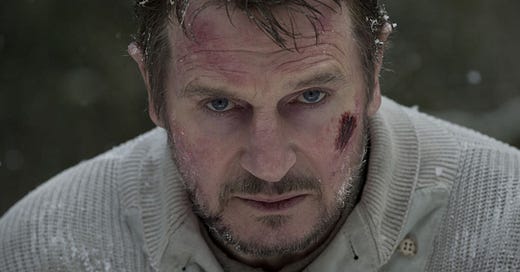The Grey

There’s almost no way to assess “The Grey” without some semblance of spoiler talk — if not about its narrative developments, at least about its melancholy mood.
It’s because this Liam Neeson-led story of men versus wolves in the Alaskan wilderness is anything but that which has been promoted — which is essentially “Taken” with carnivorous canines. Whether you find “The Grey” to be “terrifically exciting,” as the ad blurbs proclaim, depends on whether requiems rev your engine.
This is no slam on how “The Grey” builds mounting, metaphysical dread and deliverance over man’s three basic conflicts — man, nature and himself. Refreshingly, it’s every bit as contemplative as director/co-writer Joe Carnahan’s previous films (“Narc,” “Smokin’ Aces,” “The A-Team”) were chaotic. Think Jack London, not Jack Bauer.
Save a terrifying plane crash, there are no “action” sequences per se. Neeson is too shrewd and subtle a performer to simply reprise the mayhem-machine character of "Taken." And any scenes in which man punches wolf are purely incidental.
John Ottway (Neeson) is “a salaried killer” for a petroleum company operating in Alaska’s most frigid, desolate climes. Wolves are his quarry, and it’s his job to spot and snipe them before they can eat his coworkers.
Ottway is skilled with a scope and rifle, but this feels like penance for the damned (there are flashbacks to his boyhood and marriage). And when he places his hand on the heaving haunches of a wolf he’s whacked — a communion with his prey — you sense he’s searching for peace with something, anything, about death.
Neeson has rarely looked more like a predator than he does here — that beakish nose, those owlish eyes, that bear’s growl. But he’s got an anguished soul to match his mammoth strength — a great, gruff performance rooted both in Neeson’s skills and cinematic catharsis for the passing of real-life wife Natasha Richardson.
Aboard a plane flight for “shore leave” to Anchorage, Ottway’s cantankerous nature earns him a row to himself. Turns out that’s what saves him (and precious few others) when the plane goes down. Character actors Frank Grillo (“Warrior”), Dallas Roberts (“Joshua”), Dermot Mulroney (“Zodiac”), James Badge Dale (“Shame”) and Joe Anderson (“Control”) are among those playing the handful of survivors.
Ottway takes this as a rejoinder from above to the quiet questions he’s been asking, and he’s galvanized to lead these men toward survival. That’s hard enough with breath crystallizing into ice and vision gone spotty staring at blinding white in blustery wind. But then a wolf pack announces its arrival with cacophonous cries … of hunger.
If “The Grey” fails anywhere, it’s when you see the wolves in full view. Not content to settle for predators of normal size, Carnahan tries to create man-sized monsters on a miniaturized budget. Rather shockingly, some of the wolf-head effects look no better than that of G’mork 28 years ago in “The NeverEnding Story.” Thankfully, Carnahan works within this constraint only in snippets, not stretches.
“The Grey” works the nerves just as much by showing a man with a displaced knee skitter-stepping along slippery rocks. He knows he won’t merely be killed if he falls. He’ll become offal on a fine, white, powdery killing floor. To the wolves, they’re infiltrators to be dealt with using only instinct, not motivation or mercy.
And while you’ve seen men die in countless films like this, rarely do you feel the weight of their passing or the moment they decide they’re at peace with going. That “The Grey” does so for many of these men without feeling exploitative is a testament to their sturdy work in campfire-dialogue moments (especially Grillo and Roberts).
Yes, there are moments when Neeson seems to stare down Mother Nature and tell the bitch to step. But “The Grey” isn’t about proving machismo. It’s about the process of mourning and the value of dying in the company of that which calms us … even if it’s a reclamation of rage to go down swinging.
ADDENDUM: Be sure to stick around after the end credits.


